第一讲 名词性从句和状语从句的翻译
- 格式:ppt
- 大小:649.00 KB
- 文档页数:15
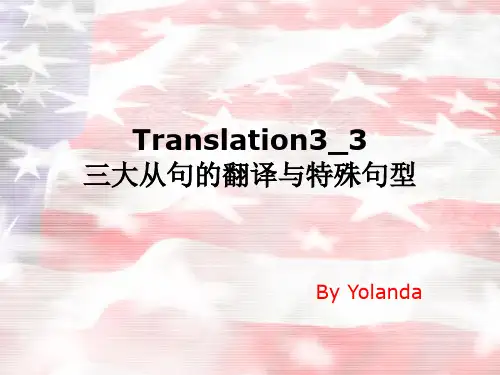
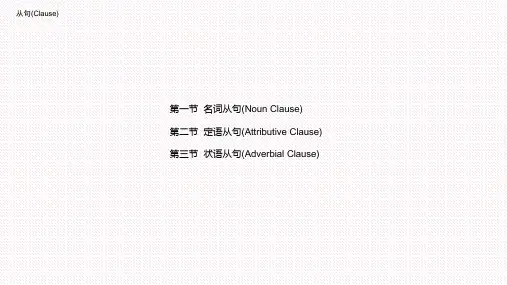
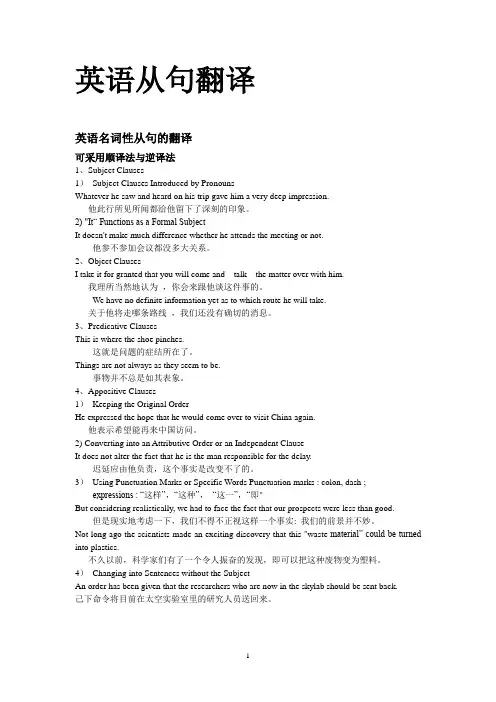
英语从句翻译英语名词性从句的翻译可采用顺译法与逆译法1、Subject Clauses1)Subject Clauses Introduced by PronounsWhatever he saw and heard on his trip gave him a very deep impression.他此行所见所闻都给他留下了深刻的印象。
2) "It“ Functions as a Formal SubjectIt doesn't make much difference whether he attends the meeting or not.他参不参加会议都没多大关系。
2、Object ClausesI take it for granted that you will come and talk the matter over with him.我理所当然地认为,你会来跟他谈这件事的。
We have no definite information yet as to which route he will take.关于他将走哪条路线,我们还没有确切的消息。
3、Predicative ClausesThis is where the shoe pinches.这就是问题的症结所在了。
Things are not always as they seem to be.事物并不总是如其表象。
4、Appositive Clauses1)Keeping the Original OrderHe expressed the hope that he would come over to visit China again.他表示希望能再来中国访问。
2) Converting into an Attributive Order or an Independent ClauseIt does not alter the fact that he is the man responsible for the delay.迟延应由他负责,这个事实是改变不了的。
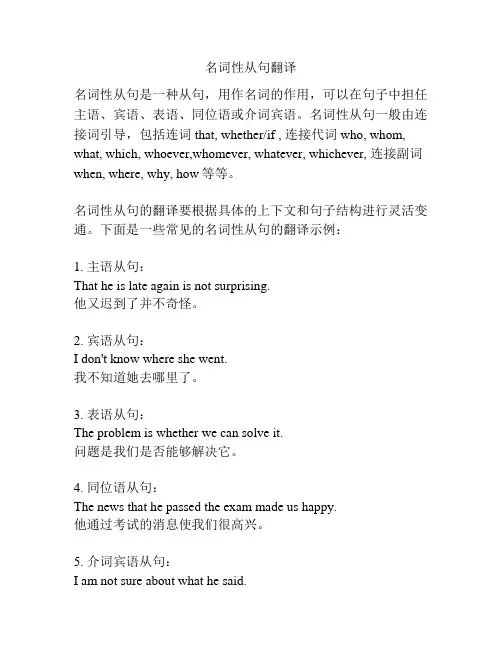
名词性从句翻译名词性从句是一种从句,用作名词的作用,可以在句子中担任主语、宾语、表语、同位语或介词宾语。
名词性从句一般由连接词引导,包括连词that, whether/if , 连接代词who, whom, what, which, whoever,whomever, whatever, whichever, 连接副词when, where, why, how等等。
名词性从句的翻译要根据具体的上下文和句子结构进行灵活变通。
下面是一些常见的名词性从句的翻译示例:1. 主语从句:That he is late again is not surprising.他又迟到了并不奇怪。
2. 宾语从句:I don't know where she went.我不知道她去哪里了。
3. 表语从句:The problem is whether we can solve it.问题是我们是否能够解决它。
4. 同位语从句:The news that he passed the exam made us happy.他通过考试的消息使我们很高兴。
5. 介词宾语从句:I am not sure about what he said.我不确定他说的是什么。
6. 间接引导名词性从句:He asked where I lived.他问我住在哪里。
7. 是否从句:I wonder whether/if she will come to the party.我想知道她是否会来参加派对。
8. 选择性从句:He asked me whether I preferred coffee or tea.他问我是喜欢咖啡还是茶。
9. 宾语从句(陈述句变为疑问句):Do you know what time it is?你知道现在几点钟吗?10. 宾语从句(连接代词):I wonder who is going to pick us up at the airport.我想知道谁会在机场接我们。
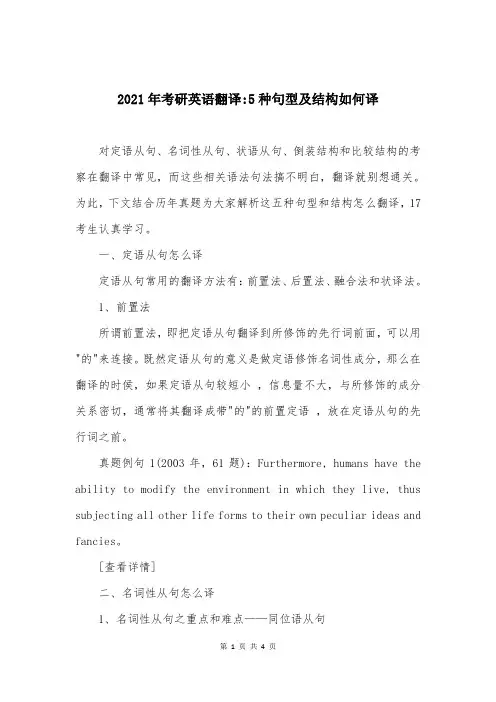
2021年考研英语翻译:5种句型及结构如何译对定语从句、名词性从句、状语从句、倒装结构和比较结构的考察在翻译中常见,而这些相关语法句法搞不明白,翻译就别想通关。
为此,下文结合历年真题为大家解析这五种句型和结构怎么翻译,17考生认真学习。
一、定语从句怎么译定语从句常用的翻译方法有:前置法、后置法、融合法和状译法。
1、前置法所谓前置法,即把定语从句翻译到所修饰的先行词前面,可以用"的"来连接。
既然定语从句的意义是做定语修饰名词性成分,那么在翻译的时侯,如果定语从句较短小,信息量不大,与所修饰的成分关系密切,通常将其翻译成带"的"的前置定语,放在定语从句的先行词之前。
真题例句1(2003年,61题):Furthermore, humans have the ability to modify the environment in which they live, thus subjecting all other life forms to their own peculiar ideas and fancies。
[查看详情]二、名词性从句怎么译1、名词性从句之重点和难点——同位语从句名词性从句包括:主语从句、宾语从句、表语从句和同位语从句。
主语从句、宾语从句、表语从句三种从句直接翻译成相应的主语、宾语和表语。
考研翻译中名词性从句的难点在同位语从句,因为汉语中没有同位语,翻译的时候要进行相应的转换。
同位语从句的作用主要是对名词作进一步的解释,说明名词的具体内容。
同位语从句常由that引导。
首先需要区分that引导的同位语从句和that引导的定语从句。
这两种从句区分的方法之一是看that在从句中是否充当成分。
若that不做任何成分,则是同位语从句,否则是定语从句。
另外从两种从句的功能上来区分的话,同位语从句是对前面的名词进行补充、说明,而定语从句是对前面的名词或代词(即先行词)进行修饰。

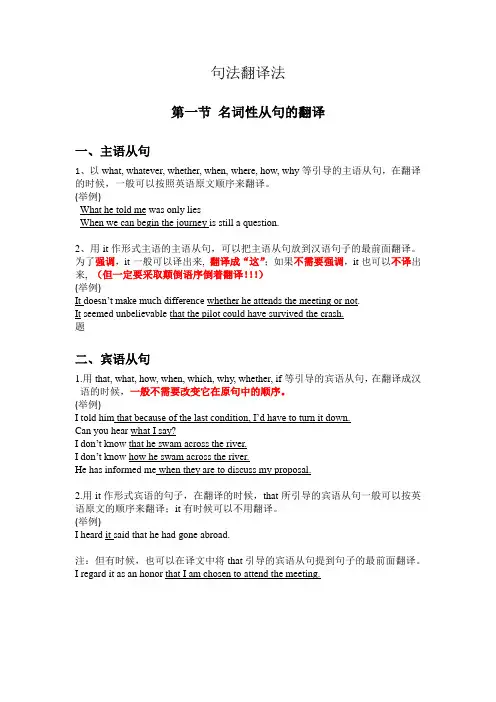
句法翻译法第一节名词性从句的翻译一、主语从句1、以what, whatever, whether, when, where, how, why等引导的主语从句,在翻译的时候,一般可以按照英语原文顺序来翻译。
(举例)What he told me was only liesWhen we can begin the journey is still a question.2、用it作形式主语的主语从句,可以把主语从句放到汉语句子的最前面翻译。
为了强调,it一般可以译出来, 翻译成“这”;如果不需要强调,it也可以不译出来, (但一定要采取颠倒语序倒着翻译!!!)(举例)It doesn’t make much difference whether he attends the meeting or not.It seemed unbelievable that the pilot could have survived the crash.题二、宾语从句1.用that, what, how, when, which, why, whether, if等引导的宾语从句,在翻译成汉语的时候,一般不需要改变它在原句中的顺序。
(举例)I told him that because of the last condition, I’d have to turn it down.Can you hear what I say?I don’t know that he swam across the river.I don’t know how he swam across the river.He has informed me when they are to discuss my proposal.2.用it作形式宾语的句子,在翻译的时候,that所引导的宾语从句一般可以按英语原文的顺序来翻译;it有时候可以不用翻译。

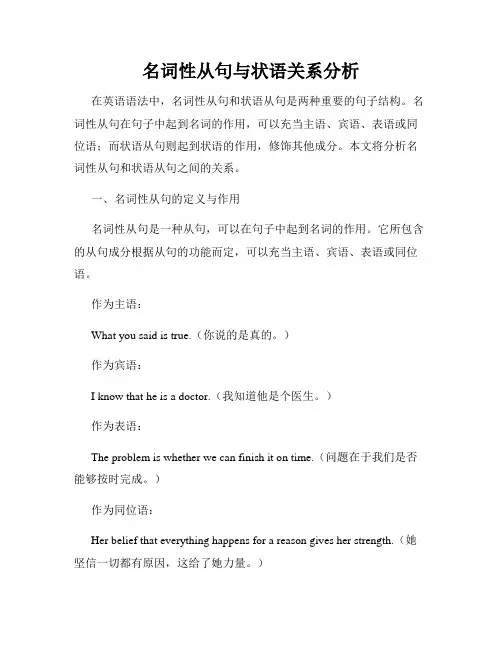
名词性从句与状语关系分析在英语语法中,名词性从句和状语从句是两种重要的句子结构。
名词性从句在句子中起到名词的作用,可以充当主语、宾语、表语或同位语;而状语从句则起到状语的作用,修饰其他成分。
本文将分析名词性从句和状语从句之间的关系。
一、名词性从句的定义与作用名词性从句是一种从句,可以在句子中起到名词的作用。
它所包含的从句成分根据从句的功能而定,可以充当主语、宾语、表语或同位语。
作为主语:What you said is true.(你说的是真的。
)作为宾语:I know that he is a doctor.(我知道他是个医生。
)作为表语:The problem is whether we can finish it on time.(问题在于我们是否能够按时完成。
)作为同位语:Her belief that everything happens for a reason gives her strength.(她坚信一切都有原因,这给了她力量。
)二、状语从句的定义与作用状语从句是一种从句,在句子中作为状语,对其他成分进行修饰。
状语从句可以表示时间、地点、原因、条件、方式等多种关系。
时间状语从句:When he arrived, we had already left.(当他到达时,我们已经离开了。
)地点状语从句:Wherever you go, I will follow.(无论你去哪里,我都会跟随。
)原因状语从句:Because it was raining, we stayed indoors.(因为下雨了,我们待在室内。
)条件状语从句:If you study hard, you will pass the exam.(如果你努力学习,你会通过考试。
)方式状语从句:She sings as if she were a professional singer.(她唱歌的样子好像是一名专业歌手。
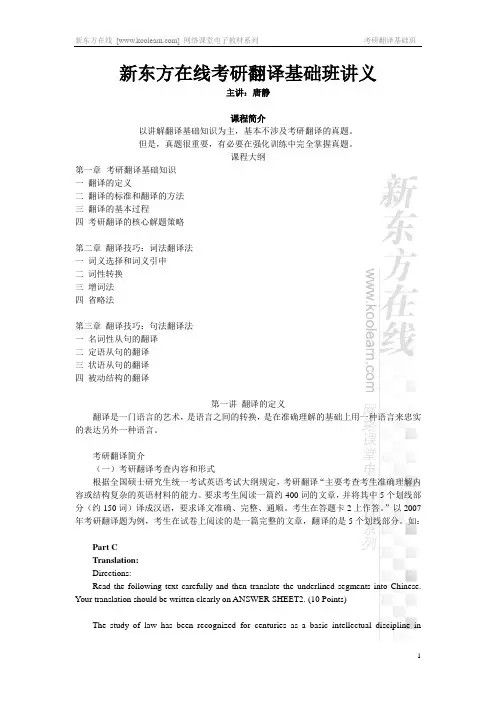
新东方在线考研翻译基础班讲义主讲:唐静课程简介以讲解翻译基础知识为主,基本不涉及考研翻译的真题。
但是,真题很重要,有必要在强化训练中完全掌握真题。
课程大纲第一章考研翻译基础知识一翻译的定义二翻译的标准和翻译的方法三翻译的基本过程四考研翻译的核心解题策略第二章翻译技巧:词法翻译法一词义选择和词义引申二词性转换三增词法四省略法第三章翻译技巧:句法翻译法一名词性从句的翻译二定语从句的翻译三状语从句的翻译四被动结构的翻译第一讲翻译的定义翻译是一门语言的艺术,是语言之间的转换,是在准确理解的基础上用一种语言来忠实的表达另外一种语言。
考研翻译简介(一)考研翻译考查内容和形式根据全国硕士研究生统一考试英语考试大纲规定,考研翻译“主要考查考生准确理解内容或结构复杂的英语材料的能力。
要求考生阅读一篇约400词的文章,并将其中5个划线部分(约150词)译成汉语,要求译文准确、完整、通顺。
考生在答题卡2上作答。
”以2007年考研翻译题为例,考生在试卷上阅读的是一篇完整的文章,翻译的是5个划线部分。
如:Part CT ranslation:Directions:Read the following text carefully and then translate the underlined segments into Chinese. Y our translation should be written clearly on ANSWER SHEET2. (10 Points)The study of law has been recognized for centuries as a basic intellectual discipline inEuropean universities. However, only in recent years has it become a feature of undergraduate programs in Canadian universities. 46)Traditionally, legal learning has been viewed in such institutions as the special preserve of lawyers, rather than a necessary part of the intellectual equipment of an educated person. Happily, the older and more continental view of legal education is establishing itself in a number of Canadian universities and some have even begun to offer undergraduate degrees in law.If the study of law is beginning to establish itself as part and parcel of a general education, its aims and methods should appeal directly to journalism educators. Law is a discipline which encourages responsible judgment. On the one hand, it provides opportunities to analyze such ideas as justice, democracy and freedom. 47) On the other, it links these concepts to everyday realities in a manner which is parallel to the links journalists forge on a daily basis as they cover and comment on the news. For example, notions of evidence and fact, of basic rights and public interest are at work in the process of journalistic judgment and production just as in courts of law. Sharpening judgment by absorbing and reflecting on law is a desirable component of a journalist's intellectual preparation for his or her career.48) But the idea that the journalist must understand the law more profoundly than an ordinary citizen rests on an understanding of the established conventions and special responsibilities of the new media.Politics or, more broadly, the functioning of the state, is a major subject for journalists. The better informed they are about the way the state works, the better their reporting will be. 49) In fact, it is difficult to see how journalists who do not have a clear grasp of the basic features of the Canadian Constitution can do a competent job on political stories.Furthermore, the legal system and the events which occur within it are primary subjects for journalists. While the quality of legal journalism varies greatly, there is an undue reliance amongst many journalists on interpretations supplied to them by lawyers. 50) While comment and reaction from lawyers may enhance stories, it is preferable for journalists to rely on their own notions of significance and make their own judgments. These can only come from a well-grounded understanding of the legal system(二)考研翻译的评分标准根据大纲规定,考研翻译的评分标准如下:5个小题,每题2分,共10分。
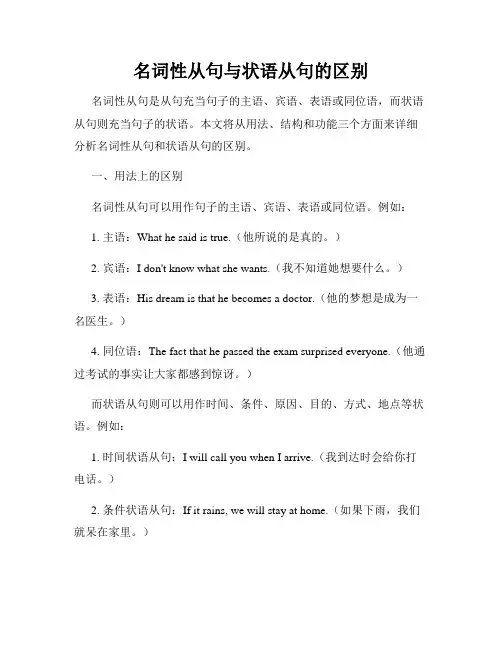
名词性从句与状语从句的区别名词性从句是从句充当句子的主语、宾语、表语或同位语,而状语从句则充当句子的状语。
本文将从用法、结构和功能三个方面来详细分析名词性从句和状语从句的区别。
一、用法上的区别名词性从句可以用作句子的主语、宾语、表语或同位语。
例如:1. 主语:What he said is true.(他所说的是真的。
)2. 宾语:I don't know what she wants.(我不知道她想要什么。
)3. 表语:His dream is that he becomes a doctor.(他的梦想是成为一名医生。
)4. 同位语:The fact that he passed the exam surprised everyone.(他通过考试的事实让大家都感到惊讶。
)而状语从句则可以用作时间、条件、原因、目的、方式、地点等状语。
例如:1. 时间状语从句:I will call you when I arrive.(我到达时会给你打电话。
)2. 条件状语从句:If it rains, we will stay at home.(如果下雨,我们就呆在家里。
)3. 原因状语从句:He failed the exam because he didn't study hard.(他没通过考试是因为他没有好好学习。
)4. 目的状语从句:She works hard so that she can achieve her goals.(她努力工作以便实现她的目标。
)5. 方式状语从句:He speaks as if he were a native speaker.(他说话的方式像是一个本土人。
)6. 地点状语从句:They went hiking where there was a beautiful waterfall.(他们去爬山的地方有个美丽的瀑布。
)二、结构上的区别名词性从句的引导词通常包括what, that, whether, who, whom, whose, which, whoever, whomever, whichever等。
定语从句译法(一)译成前置定语(二)后置并列分句(三)溶合译法(四)译成状语●The traders wanted safe access to large quantities of Oriental spices,which the European world had come to like, and which people needed for presenting food in days before the introduction of cold storage.商人们想平安无事地获取大量的东方香料,这些香料已经为欧洲人所喜爱,而且在没有发明冷藏法的当时,香料也是人们储藏食品所必须的。
●I had seldom met an American who served in China during World WarII who had not known Zhou Enlai.二战期间曾在中国工作过却不认识周恩来的美国人很少见。
●译成前置定语:●This is the soldier who just returned from the front.译文:这是刚从前线回来的战士。
●To be sure, a great rebuilding project would give jobs to those ofpeople who need them.译文:诚然,一个宏伟的重建计划也许能为许多需要工作的人提供就业机会。
●In recent years, however, people have begun to become aware thatcities are also areas where there is a concentration of problems. 可是,近几年来人们开始意识到城市也是问题成堆的地方。
●Chemistry deals with changes in matter as a result of which it ispossible to form a new substance.译文:化学是研究物质变化的,这种变化的结果能够形成新的物质。
语法句式与翻译技巧主题:语法句式与翻译技巧导语:语法句式和翻译技巧对于学习一门外语来说是非常重要的。
它们不仅可以帮助我们准确地表达自己的意思,还能够提高我们的翻译能力。
通过本节课的学习,我们将学习一些常用的语法句式,并学习如何运用这些句式进行翻译。
一、复合句复合句是由一个主句和一个或多个从句组成,通过连接词或连接词组来连接。
通常从句可以分为名词性从句、定语从句和状语从句。
下面我们来学习一下如何翻译复合句。
1. 名词性从句名词性从句在句子中充当名词的作用,可以作主语、宾语、表语或同位语。
翻译时一般采用“that”引导的从句。
例句:I believe that he will pass the exam.我相信他会通过考试。
2. 定语从句定语从句用来修饰名词或代词,说明其具体的内容、特征等。
翻译时可以用“which/that/who”引导的从句。
例句:The book that I am reading is very interesting.我正在读的那本书非常有趣。
3. 状语从句状语从句用来修饰整个句子,表达时间、条件、原因、目的等。
翻译时根据从句的具体内容使用相应的连词。
例句:I will go to the party if I have time.如果我有时间,我会去参加派对。
二、虚拟语气虚拟语气是一种表示虚拟或不确切的语气形式。
它通常用于条件句、愿望句和建议句中,以表达一种假设、猜测或非事实的情况。
下面我们来学习一下如何翻译虚拟语气。
1. 条件句条件句分为三种类型:与现在事实相反的条件句、与过去事实相反的条件句和与将来事实相反的条件句。
翻译时可以根据从句的具体内容使用相应的虚拟语气形式。
例句:If I were you, I would take this opportunity.如果我是你,我会抓住这个机会。
2. 愿望句愿望句用来表达对现在或将来情况的希望或愿望。
翻译时可以使用“希望/但愿/要是…就好了”等表达。
英语名词性从句的翻译英语名词性从句包括主语从句, 宾语从句, 表语从句和同位语从句, 在翻译这类从句时, 大多数可以按照原文的句序翻译成相应的汉语, 但是也有一些具体的处理方法, 下面我们结合一些实例加以说明:例1.How and when human language developed and whether animals such as chimpanzees and gorillas can develop a more elaborate system of communication are issues at present being researched, but as yet little understood.人类的语言是如何发展起来的, 是什么时候形成的, 诸如黑猩猩和大猩猩一类的动物是否会形成一种更加复杂的交流系统, 都是现阶段人们研究的课题, 但对此人们都知之甚少。
(主语从句)例2.How well the prediction will be validated by later performance depends upon the amount, reliability, and appropriateness of the information used and on the skill and wisdom with which it is interpreted. (95年考题)这些预测能在多大程度上被后来的成绩所证实取决于所使用的信息的量、可靠性和适合程度, 并取决于对信息作出解释的技能和智慧。
(主语从句)例3.It is often said that wide reading is the best alternative course of action but even here it is necessary to make some kinds of selection.人们常说, 大量阅读是可供选择的最佳方案, 但即使在这一方面, 也需要某些选择。